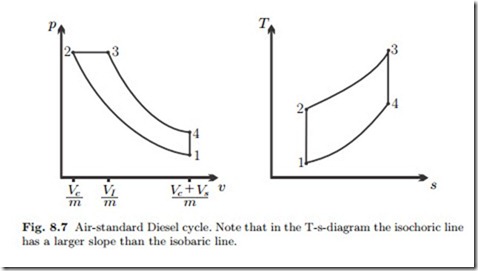Diesel Cycle
In the Diesel cycle, named after its inventor Rudolf Diesel (1858-1913), only air is drawn in and compressed, and the fuel is injected after the compression. Here, one utilizes the temperature increase of the air in compression: as the fuel is injected it starts to burn in the hot compressed air. The compression ratios of Diesel engines can be substantially higher than those of Otto engines, with values of up to r = 30.
However, injection of the fuel is slow, and the injected fuel disperses into droplets which are not as well mixed with the air as the gasified fuel in the Otto engine. Therefore combustion is slower than in the Otto engine, the piston moves as the fuel burns. This process can be modelled as an isobaric heat transfer process, so that the Diesel cycle is modelled as follows:
Stroke II: 1-2 adiabatic compression
Stroke III: 2-3 isobaric heating (slow combustion during fuel injection)
3-4 adiabatic expansion
4-1 isochoric cooling (exchange of working fluid)
The respective process curves are shown in Fig. 8.7, which also indicates clearance volume, swept volume, and the injection volume Vi, which is the volume at the end of the isobaric heating process. For further analysis we assume reversible processes for which we find heat and work as
For the two isentropic processes we have, still using the cold-air assumption,
For the same compression ratio r the Diesel efficiency is below the Otto efficiency. However, the Diesel cycle allows significantly higher compression ratios than the Otto cycle, and that is the reason why it has a larger efficiency. For a cycle with cut-off ratio rc = 2 and compression ratio r = 20, we find the thermal efficiency as 0.65. Irreversible losses to friction in the engine and drive train reduce the thermal efficiency, actual engines have efficiencies around 37%.
From the p-v-diagram we can see that in a Diesel cycle the maximum pressure is sustained for a longer period, in contrast to the Otto engine, where the maximum pressure is just a short spike. Due to this, Diesel engines must be build more sturdily, which is the main reason why they are more expensive. On the other hand, they are more efficient, and thus require less fuel. The cost of gasoline and Diesel fuel, respectively, also depends on taxation, and thus it might be more cost effective to drive a Diesel powered car in some countries, while an Otto powered car might be more cost effective in other countries.



